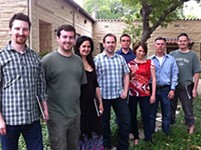Jorge Caballero & Virtuosi
The classical guitarist and a few gifted friends created an engrossing evening of music
Reviewed by Michael Kellerman, Fri., July 31, 2009

Jorge Caballero & Virtuosi
Mexican American Cultural Center
July 24
Ah, the sweet risk of high expectation, that feeling you get when something you've been waiting for finally arrives. After wooing audiences with his tremendous artistry last summer, Jorge Caballero made a more than welcome return to Austin,
with his local fans cramming into the minimalist theatre of the Mexican American Cultural Center to hear what the classical guitar master would present next.
Caballero's artistic team included New York violinist Maria Conti, Austin Symphony Orchestra principal cellist Douglas Harvey, and Austin Lyric Opera mezzo soprano Elizabeth Cass. The performance opened with a string trio by Argentine Jorge Morel, an impressionistic rhapsody anchored beautifully by Caballero, allowing Harvey and Conti to drift gorgeously above on Morel's evocative melodic brushstrokes. The piece's whimsical, moody jaunts suggested a walk through the streets of a crowded summer city, a casual and fitting opener.
Caballero then gave Conti the spotlight, accompanying her on the impressive "Danza" of Manuel de Falla, which, in Conti's able hands, was every bit the showpiece a Kreisler violin arrangement should be.
The duo continued with Astor Piazzolla's witty "L'histoire du Tango," which begins in 1900 and jumps 30 years with each movement, tracing the tango's development over time. From the sentimental, buttoned-up salon treatment of the opening movement through the jazz influences and harmonic density of 1930 to the playful layers and rock & roll nuances of 1960 and the suggestions of atonality and embraced chaos as the composer nears his death in 1990, this was a triumph of sound, rhythm, and musical storytelling. Caballero and Conti played as one, nailing the work's arching moods.
The gorgeous Elizabeth Cass, in a flowing black dress with a searing blood-red wrap, cast herself beautifully for de Falla's Seven Popular Spanish Songs, which brought all four musicians together on stage for a second act. The songs, each a short but powerful statement of Iberian character, were rich material for Cass. Standouts included "Seguidilla Murciana," featuring the assured, rapid-fire accompaniment of the string players; the gorgeous "Asturiana," Cass' expressive mezzo in top form; the meditative "Nana," which set Cass' gliding notes to Caballero's simple, effective guitar rhythms; and finally the angry, passionate "Polo," which built into a huge, thrilling final note.
Caballero closed the concert on an intimate note, presenting three self-arranged songs inspired by his mother, a master singer of the música criolla of his native Peru. From the lovely and soulful notes of "Palomo Enamorado" to the energetic, wistful flourishes of "Fina Estampa," the pieces offered the night's sole taste of Caballero's famous virtuosity. The audience, inspired, rewarded the musicians generously.
Now back to the risk of expectation. As a whole, this was an entirely engrossing evening of music, infused at all moments with the rich versatility of classical guitar. When he took the stage, however, Caballero did so as the enormously talented winner of virtually every international award in his field, a superstar who won the a Naumburg award at age 19, the youngest and the first-ever guitarist to win the coveted classical music prize. Though it was nice of him to offer his colleagues the limelight, the night's surprise ended up being the lack of solo guitar material, of awe-inspiring technique, the trademark Caballero stamp. Perhaps this was the master's own savvy point, though: Surely he'll be back in Austin soon, so what's wrong with keeping his audience wanting more?










